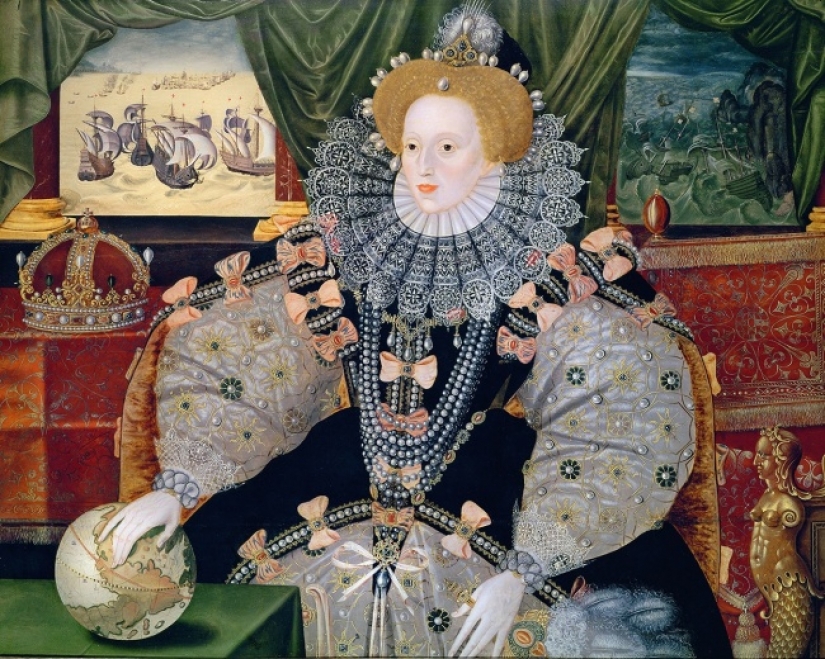Crazy beauty techniques from the Past that make the hair stand on end
Over time, ideas about female beauty changed, and sometimes the words "beauty requires sacrifices" had the most literal meaning. What women did to themselves in order to be considered beautiful, today can plunge into shock. Here are a dozen examples from the past that confirm that you should not chase changeable fashion and the main thing is still health.


Chopins
Girls in the XV—XVII centuries. ekah had to wear chopins (also zoccoli or pianelle). So they protected their beautiful outfits from the dirt that covered the streets, and demonstrated their high social status. The height of the chopins could reach 50 centimeters. It is no wonder that the ladies had to resort to the help of maids, who were always there to support their mistress and not let her lose face in the dirt. Literally.

Protection for makeup sample of 1939
In this way, fashionistas tried to protect their makeup from rain and snowfall. The bad thing is that this strange device quickly fogged up from breathing.
Dimples on the cheeks
In the XX century, there was a time when the femininity of the image was considered insufficient if the girl did not have charming dimples on her cheeks. In 1923, a special device was patented, which, according to the inventors, was able to give beautiful dimples to anyone who wanted. The device was put on the face, fixed behind the ears and on the chin, and two protruding rods pressed hard and painfully on the cheeks. After some time of such use, the desired dimples appeared on the face.

Renaissance Era: high forehead, lack of eyelashes
During this period, naturalness was not particularly appreciated, people began to actively use cosmetics, and the female body was raised to a cult. A high rounded forehead was especially fashionable, and the higher the hairline was, the better. Therefore, many women shaved their forehead hair to meet this standard of beauty. In addition, fashionistas certainly got rid of their eyelashes by plucking them with tweezers.

XVII century in England: white skin
A product with mercury and vinegar was used to whiten the face. The skin really became whiter, but over time it turned yellow, and this process was irreversible. Queen Elizabeth I of England was an ardent fan of bleaching cosmetics. Her face has reached such a degree of whiteness that it is remembered in history as the "mask of youth".
The XVII century in England: translucent veins
To emphasize their high origin, women used a blue pencil with which they drew a venous pattern on their neck, chest and shoulders.

The Victorian Era: Lip biting
Queen Victoria of England banned women from using cosmetics, but this did not stop them in search of a way out of the situation. Instead of applying lipstick and blush, they pinched their cheeks and bit their lips.

XIX century: arsenic on the guard of beauty
In the XIX century, it was fashionable to use arsenic inside to " give a blooming look to the face, shine to the eyes, and an attractive roundness to the body." Nevertheless, there were also side effects: arsenic accumulates in the thyroid gland, which can provoke the formation of goiter and lead to death.
Victorian Era: Toxic Green dresses
In the Victorian era, a green dye was invented, and the bright fabrics dyed with it became popular among fashionistas. This shade was called "Scheele Green". To achieve it, a mixture of arsenic and copper was used. The poisonous substance gradually killed the one who wore a dress made of fabric dyed with this dye. When in contact with the mucous membranes, the paint caused irritation and gradually penetrated through the skin. By the way, the wallpaper was painted with the same dye, so that the green walls in rich houses were fraught with a deadly risk for the owners and their guests.

Europe, the XVIII century: flies
At that time, people used cosmetics without hesitation, and special importance was attached to artificial moles-flies. They have become not only a way to decorate the face, but also a tool for flirting. For example, a fly in the form of a crescent moon meant an invitation to a night date, a cupid fly meant love, a carriage meant consent to a joint escape. The fly above the upper lip meant that the girl was free and open to marriage proposals. If the artificial mole was located on the right cheek, it meant that the woman was already married. Widows wore flies on their left cheek.
Keywords: Appearance | From the past | Beautiful | Past | Standard | Then and now
Post News ArticleRecent articles

Thailand is a kingdom of amazing beauty, where the colors of nature mingle in a captivating palette of rich and varied landscapes. ...

Hamsters are one of the cutest animals in the world, and they are quite easy to keep. No wonder they are so popular. We have ...
Related articles

Girls from our collection could easily compete for the title of "Miss universe". And this despite the fact that they are all ...

Petersburger Polina Brzezinsky @polinabrz travels the world with her husband and shares with hundreds of thousands of subscribers ...

It is easy to imagine how dangerous was the percentage of feminists in Muslim Central Asia two centuries ago. However, even then, ...

May West once jokingly said that she should be given a license to invent sex, which she discovered for Americans. The name of this ...